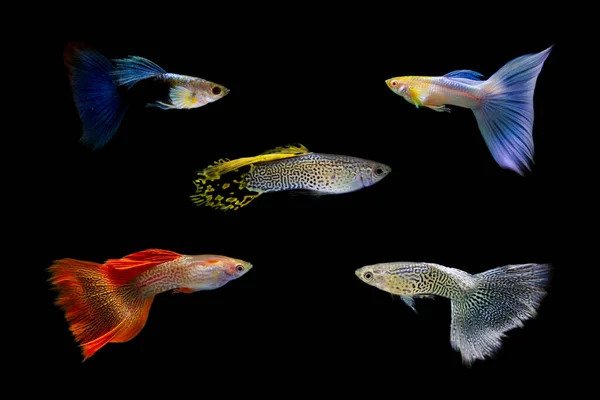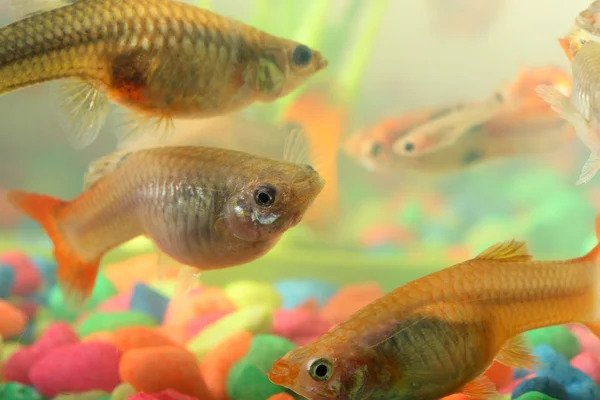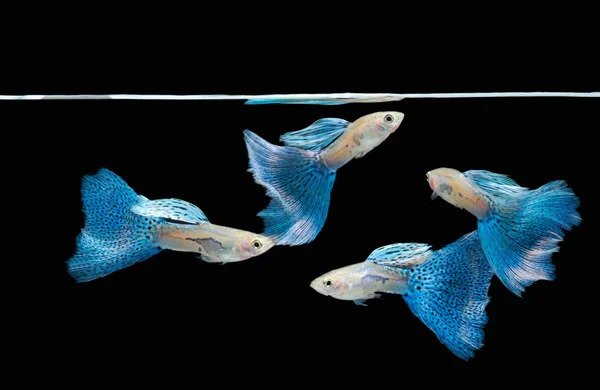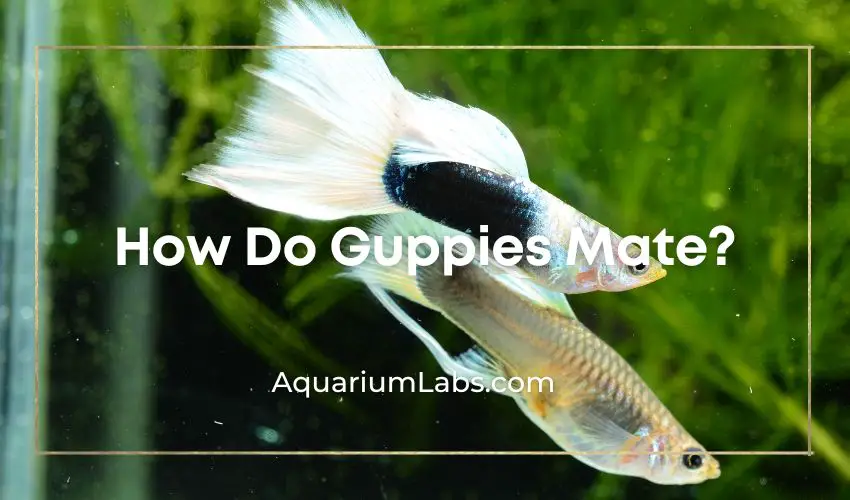Guppies do not lay eggs. These tropical fish are livebearers and will readily reproduce if the condition of the fish tank is favorable.
However, guppy breeding can be too much to handle if you are unaware of how guppies mate and what you can do to protect your guppy fry.
Here is a detailed explanation to answer that question; how do guppies mate?
You will also learn many other important things about guppy mating. Read on to find out.
How Male Guppies Mate With Female Guppies

There are two ways male and female guppies mate. The first is consensual courted mating, while the second is forced copulation, where the male guppies sneak up on the female guppies.
In the first instance, the mating ritual starts with the male guppies displaying some weird behavior, like dancing and chasing the female guppies. It ends when the female guppies respond to the advances of the male.
Essentially, you will find the male guppy dancing and chasing the female guppy for hours. The mating ritual ends when the female guppy chooses the male. She shows receptive behavior by allowing the male to briefly insert his gonopodium into her genital pore.
This is how the male fertilizes her eggs internally. His gonopodium briefly makes contact with her genital pore so that he can transfer his sperm into her urogenital pore. All of this happens in seconds.
At the end of this mating ritual, the female fish will have obtained enough sperm to birth several batches of guppy fry without going through another mating ritual with any other male guppy.
What Happens After Male and Female Guppies Mate

After the male fertilizes her eggs, the next stage is the gestation period. This is the period when she carries the pregnancy, and it ends after she gives birth to her fry.
The gestation period can be anywhere between 21-30 days. But it depends on several factors. They include:
Tank Condition
It is very important to ensure that the water quality of your aquarium is optimal for guppy breeding. You need a stable water temperature between 77°f – 80.6°f for the guppy gestation period to successfully occur between 21-30 days.
You also want to keep the rocks and plants in the tank to ensure that your pregnant female guppies have hiding places to expel their fry after mating. You can also lower the temperature below the recommended range for breeding to frustrate guppy breeding.
Absence of Stress
When pregnant female guppies come under stress, you may find dead eggs in your tank. This is usually because stress can not only delay the gestation period but also lead to poorly formed eggs.
When eggs are not properly formed in the guppy, instead of giving birth, your female guppy will expel the eggs from her body to prevent severe health issues.
Some things that can cause stress include poor water quality and starvation. Most importantly, you want to keep a stable pH level. A sudden change in water parameters can also cause stress for your female guppies.
How To Tell a Male Guppy From a Female
It is easier to tell a male guppy fish from a female when he becomes sexually mature. Male guppies usually have more vibrant colors than females.
Another way to identify male guppies is with their sizes. They are usually smaller than female guppies.
You can also identify them with their sex organ. You want to pay attention to their anal fins. The anal fin of a guppy serves another function apart from helping with navigation.
It doubles as the sex organ and is not as pronounced as the female guppy’s. Their anal fins are also less pointed than the anal fin of a female guppy.
Finally, you can tell male guppies from females with the gravid spot. Only females have gravid spots. This is a dark spot that females have right behind their anal fins. It is the identifying mark of many livebearers. It grows larger as the delivery date closes in and is only found in females.
How To Recognize a Pregnant Female Guppy

Ordinarily, female guppies are usually bigger than males. But when they become pregnant, they tend to have a more bulgy stomach.
However, there may be other reasons for the bulgy stomach. So the best way to identify a pregnant female if you missed the mating ritual is the gravid spot in females.
Again, this gravid spot is located behind the anal fin of the female and is a fool-proof indicator of pregnancy in females.
Protecting Baby Guppies
Although peaceful, guppies eat their fry after birth. Apart from the threat of becoming food to adult guppies and other fish, the fry can also die from poor water quality due to the accumulated waste from the overcrowded community tank.
The best way to protect baby guppies is to have them in a separate breeding tank. They will get more attention and care in a separate tank than in the main tank. You want to keep them at 85°f and feed them at least 5 times daily. But ensure that the food items are small enough for them to eat.
Also, if you want to control the guppy population in the main tank, separating the fry is a good way to remove how many fry you want back in the main aquarium and how many you want to get rid of.
Preventing Guppies Breeding Process
If you do not have plans to keep too many guppy fish in your fish tank, preventing females from getting pregnant or giving birth to baby guppies tends to be the best way to do so.
You may be too late if you opt to identify and remove the male fish from the fish tank after it has attained sexual maturity. Identifying male guppies is rarely possible until they have attained sexual maturity.
Once the males have become sexually mature, it only takes seconds to fertilize the eggs in the female guppies. So even after identifying and expelling them, you may keep females with deposits of male guppy sperm.
One way to prevent guppies from breeding after expelling the males is to make the tank inconducive for the females for a short while, especially when you find your female guppies with pregnancy symptoms.
This will stress the females so that they do not birth baby guppies. If they birth baby guppies, the poor water quality will reduce the number drastically if they survive the harsh tank conditions. But you want to frustrate the pregnancy only for a short while.
You can also remove the fry with a net and use them as feeder fish for other aggressive predatory fish in separate aquariums.
Can I Cross Guppies With Other Poeciliidae Species?
Guppies are freshwater livebearers from the Poeciliidae family. Other fish species in this family include Molly, Platyl fish, and the swordtail fish.
They also give birth to offspring like guppies. Normally, guppies breeding with these other livebearers in the same family occurs when there is no opposite sex for mating. One of the most cross-bred fish with guppies is the Molly fish.
But the problem with this cross-breeding is that their fry rarely survive after birth. If the fry survive, they are usually unable to give birth to babies because they are not fertile.
Selectively Breeding Guppies

Selectively breeding guppies is usually because the pet owner wants guppies of a particular color in the aquarium or outdoor pond. Other reasons include the physical characteristics of the guppy and or a unique feature of the fish, like the tail shape.
The most crucial step is identifying the male guppy and a healthy female guppy for selective breeding. You want to put them both in the same tank you prepared for this selective breeding purpose.
Remember, those female guppies can be gravid even months after the first sexual encounter with a male guppy because they store sperm. They can continue to deliver guppy fry after that first encounter without mating with any other male.
So it is vital to ensure that your female guppy is not carrying fertilized eggs from other male guppies, as this will defeat the purpose of selective breeding.
After ensuring that you have the right pair, the rest depends on the quality of the water in the aquarium, the right breeding temperature, and other fish care routines to ensure that the female does not come under stress after she becomes gravid.
Do not forget to separate the fry from the guppy parents after the pregnant guppy has birthed her live offspring.
References:
- https://en.wikipedia.org/
- https://www.theaquariumwiki.com/

